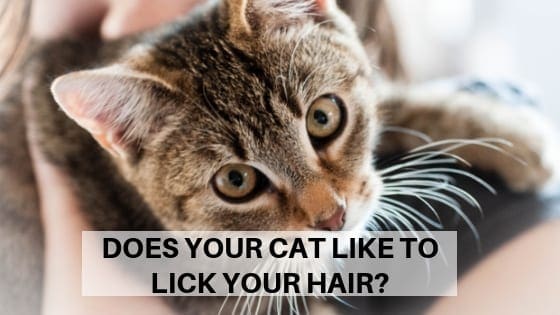
Here’s the typical scenario: you’re sound asleep in bed when a very strange feeling wakes you up. You reach up to your head and feel a section of your hair is wet. Looking over, you see your cat’s face. She looks at you for a moment and then goes back to what she was doing – licking your hair. You realize, by the soggy strands on your head, the cat has probably been doing that for quite a while. Why would a cat want to repeatedly keep licking your hair?
Social Behavior
Grooming is a common behavior between cats who have a bond. It’s not unusual to see two cats engage in a session of licking each other’s head and neck. I have watched as the recipient of the licking closes her eyes and almost seems to drift off into dreamland.
For some cats who are very bonded with particular family members, the social behavior of hair licking is very normal, and of course, since the biggest crop of hair can be found on the head, that’s where they camp out.
Appealing Taste or Scent
For other cats, certain hair products such as shampoo, hair spray, hair gels, etc., may hold a certain appeal as far as taste or scent. Some cats may engage in licking the hair of their cat parent just because they like that particular “flavor.”
Attention Seeking
Some cats will engage in this behavior because previous experience has shown them that it always gets your attention. Make sure you’re providing enough environmental enrichment so the cat has other ways to work off energy. Additionally, engage your cat in interactive play sessions at least twice a day for about 15 minutes each session. If your cat has a typical time that she comes over to engage in hair licking, do the play session right before that.
Self Soothing
A cat may engage in repetitive licking of your hair, and even their own hair to self soothe. The action has a calming effect. If the behavior is becoming obsessive, or you start to see bald spots on your cats own body, contact your veterinarian. The over-grooming behavior may be the result of stress.
How to Stop the Hair Licking Behavior
The best way to stop the behavior is through redirection. First though, you have to identify the reason for the behavior. Is it a social behavior? Attention-getting? Stress relief? Figure out the reason why the behavior is happening so you can develop the most effective behavior plan.
To distract, be ready with toys, puzzle feeders, or whatever your cat enjoys, so you can redirect the behavior. It’s best to do the redirection before the actual behavior begins. The redirection is to change the cat’s mindset to something more constructive. For example, offering a puzzle feeder will provide the cat with a confidence-building activity that will offer a reward at the end. Even tossing a small toy for your cat to go after will switch the mindset to something positive.
If you’ve been able to pinpoint that certain hair products may be the culprit, switch to ones with no scent or a scent that isn’t so cat friendly. Cats generally don’t like the smell of citrus so look for shampoos and gels with a lemon scent.
Need More Information?
For more information on cat training and cat behavior problems, refer to Pam’s best-selling books. Pam’s books are available at bookstores and also online. We’ve included links to Amazon here on our website.
If you have a question about your cat’s behavior or health, contact your veterinarian. This article is not intended as a medical diagnosis nor is it a replacement for your cat’s regular veterinary care. This article is for general information purposes only.




